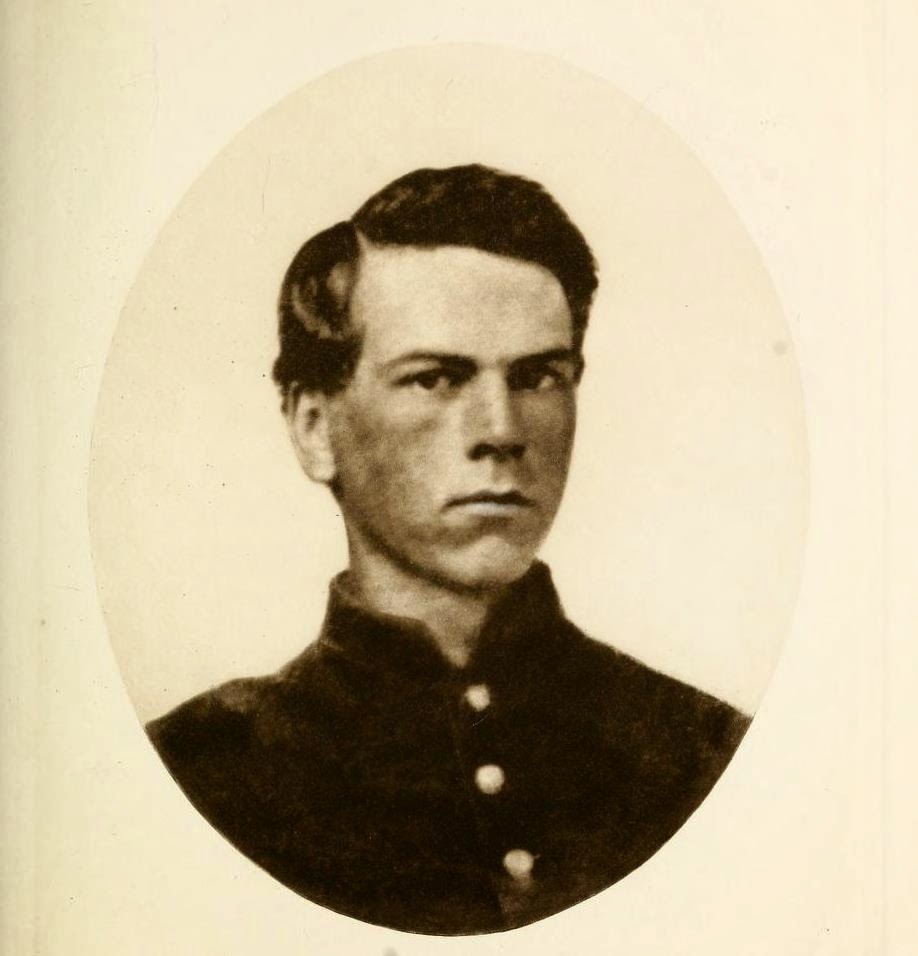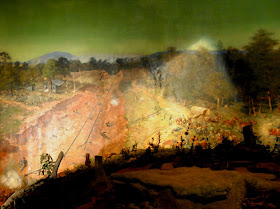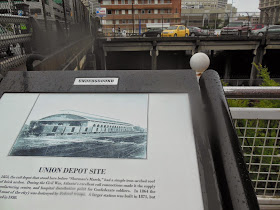 |
| A.J. Riddle took photo of prisoners in August 1864 (Library of Congress) |
Like other diarists at Andersonville prison, Pvt. Samuel Melvin faithfully recorded the day’s meager food rations and the weather. These Union soldiers understood the term “death by inches” – the body’s slow descent from illness, exposure to the elements and malnutrition.
Melvin’s little-known
account of his imprisonment at Camp Sumter in central Georgia takes the reader
beyond the grit, grime and the gnawing hunger. His is a journey to the soul.
From daily
entries during the summer of 1864:
June
4: “… It is sad to see
them carry the dead by into the dead house, a continual train of them all the
time. How I hope that I shall live through it and be permitted to enjoy the
true fruition of my life, which I have put so much confidence in and placed
such bright anticipations upon! Still, if I die here I am sure that we shall
die in a good cause, although in a brutal way.”
June 25: “… Sam is in poor spirits, but I am getting as well as could be expected.
But then, I am almost distracted, for things are dubious here indeed, and all
we have to console us is to hope for better things. The seeming joy is great,
that I have in thinking of the joy that I will have when I see the Stars &
Stripes, for then I soon will see my friends. Orders came to give back the
money taken from old prisoners. That is [a] good indication, but money nor
anything can ever compensate us for one week's stop here.”
July 7: “… I
dreamed last night of being paroled and seeing Dow, and the disappointment when
I awoke & found myself still in Hell! — I have given up all hopes of hearing
from home, likewise of their hearing from me. But while there is life there is
hope, and that consoles me.”
 |
| Samuel Melvin |
Because of
their detail and emotional nature, the words written 150 years ago by Melvin, one of
three brothers to serve in the Civil War, are being featured each day this summer
on Andersonville National Historic Site’s Facebook page. Officials hope virtual visitors will see the prison in a new light.
“Diaries tend
to be very cursory, the variables that change, weather and food,” said Eric
Leonard, acting superintendent. “They don’t often describe emotion or landscape,
but once or twice. Samuel’s diary is very expressive.”
Melvin, of
the 1st Massachusetts Heavy Artillery, and 32,000 others were at
Andersonville in August 1864, the darkest month and the apex of misery at the Confederate
prison.
This weekend’s
“First Saturday” program at the park
will focus on prisoner desperation. Rangers and volunteers will spotlight the
trials of those arriving at Camp Sumter and will take visitors on walks through
the prison site and Andersonville National Cemetery, resting place for nearly
13,000 who succumbed in just 14 months at the prison.
“Relief came
in only two ways that month; a storm that washed over the prison site and
revealed a spring that prisoners called "providential" and rumors of
liberation under General Sherman approach gave hope to the desperate men,” the
park said in a press release. “While the spring water aided the prisoners,
freedom was not so easily gained.”
 |
| Re-enactors portray prisoners (ANHS) |
Camp Sumter’s
population had skyrocketed because of Grant’s Overland Campaign in Virginia.
Thousands of Union soldiers taken captive were quickly sent to Camp Sumter.
“By August,
10 percent of the Army of the Potomac is at Andersonville,” said Leonard.
Melvin, 20, was
captured at Spotsylvania, Va., on May 19 and arrived at Andersonville on June
3.
More than
4,000 men had died at Camp Sumter by late July. The situation worsened in
August, when the population reached an all-time high, before dropping
substantially when Atlanta fell in early September and more than half of its prisoners
were moved.
On Aug. 15, 120
men died. Aug. 22 saw 122 deaths and 127 succumbed the next day. There were
many days that witnessed between 90 and 120 deaths.
 |
| Captive Thomas O'Dea years later sketched prison, including great storm |
“Shelter is
such a rare commodity,” said Leonard. “All that is being compounded by the fact
you cannot escape the sun and heat.”
Some
prisoners dig into the mud to escape the sun. Others dig in a desperate effort
to escape.
Guards by
late summer have detected 80 such attempts. While 45,000 prisoners were housed
at Andersonville over its existence, only 33 successfully escaped.
“Andersonville
is essentially escape-proof,” said Leonard. “And yet people are trying every day.
A tunnel gives you hope, leadership, coordination and secrecy. Equally
important, it is resistance.”
When caught,
those few who made it outside might be put in stocks or wear a ball and chain
before being thrown back in the general population. “There is nothing worse
than that.”
 |
| Plaque shows prisoners using pole, sticks to reach spring water |
There was no
shortage of rumor and speculation among the prison population. Within a few
days, Melvin learned that Atlanta had fallen. Many soldiers were kept alive by
(dashed) hopes that they might be paroled or exchanged.
“The communication
chains are very fast,” Leonard told the Picket. “Getting news …. Prisoners are
hungry for that information.”
Prisoners were
enduring a hot and wet summer. The only place that grass grew through the mud
was between the stockade wall and the dead line, which prisoners could not
cross without risk of being shot.
“If you are
not washing yourself, you get filthy and that feeds into getting sicker,” said
Leonard.
On Aug. 9, a
huge storm arrives at Andersonville. Stockade Creek overflows. Walls on two
ends are breached and guards fire artillery overhead in their call for general
quarters.
The good news
for the soldiers was that much of the excrement that has piled up over the
months is washed away, at least temporarily.
 |
| Veterans visit Providence Spring in 1897 (Georgia Archives) |
 |
| Providence Spring area today (ANHS) |
According to
tradition, the prayers of many were answered after lightning struck the
miserable compound.
A spring is exposed on the west side of prison,
not far from the dead line. Prisoners attached metal containers to tent poles
or sticks so that they could reach the water. That scene is depicted in a
bronze tablet on the park’s Pennsylvania memorial.
“At some
point a barrel head is played over the spring outlet and they channel it so you
do not risk the dead line,” said Leonard, adding that there are accounts
indicating 2,000 men at a time might line up to draw water.
“In a place
where clean water is dream, this is clean water coming out of a hillside,” said
Leonard. “It was literally a gift from God.”













































